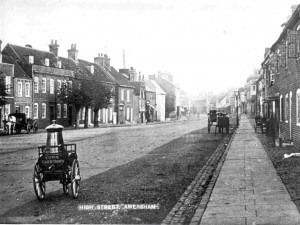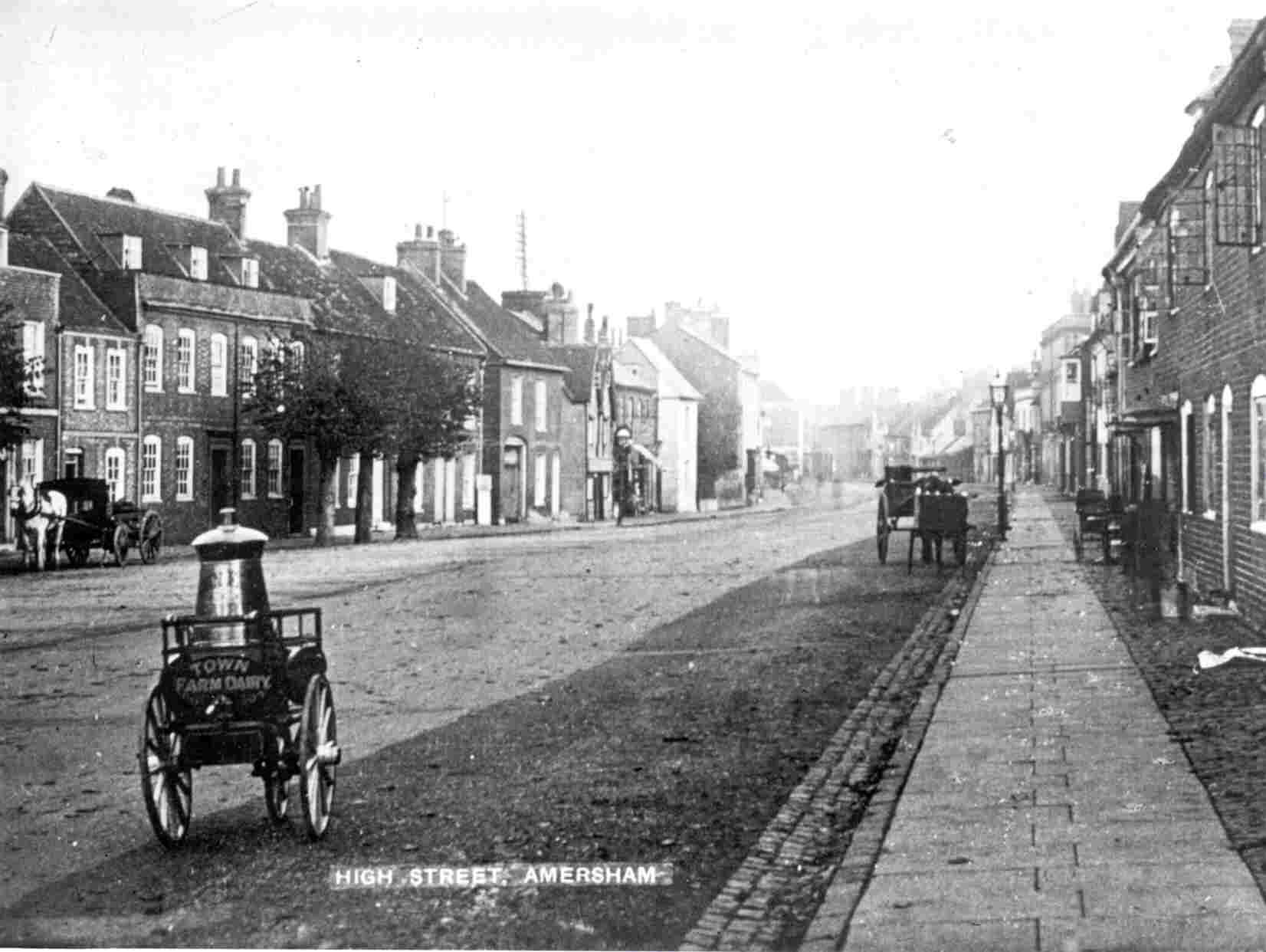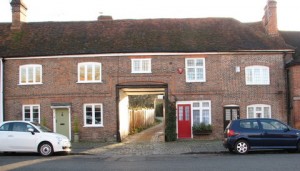This article about Town Farm was written by Gerry Selby with help from the owners
Originally this was ‘Town Farm House’, built in the 17th Century and altered in the 18th Century, made up from two cottages ( 106 & 106a High Street) adjoining The Swan. The house was rebuilt as we know it now in 1798 – a date stone of that year was found in the back garden. The two cottages were occupied by a cobbler and a coffin maker. Both had wells in the back. (One of these wells is now under the kitchen floor of the eastern cottage and was beautifully constructed, all twisted and decorative, like the chimneys at Chenies Manor.) The front is of red brick and black headers and has a large covered gateway, inserted or made higher in the 18th Century.
But there is mention of Town Farm a hundred years before, when a John Charsley was paying rent for the house and its back yard. By 1739, a Mr Stephen Squire, carpenter, was paying a rent of £6 per annum to William Drake of Shardeloes. By 1744, Stephen Squire, the elder, had left the property to his son, another Stephen Squire who also paid his rent to William Drake. He also had to pay window tax on 13 windows in 1765. This Stephen had married Mary and they had a son, Thomas, who in 1757 had moved to London and became Cornet of HM Troop of Horse Guards. At this point, William Weller, the elder, a brewer, took over the house.
The 1851 Census records a William Salter, 36, also a farmer and employing 7 men. The 1881 Census records a Mary Williams, a brazier, and her son, Frederick, living there, and by 1891 Mary, now 65, was a farmer.
In 1910 a valuation was done on Town Farm by William Tyrwhitt-Drake, putting the land belonging to the farm as 37 acres, and now being run by A P Hoare as a dairy farm. [See a photo of workmen at Town Farm in 1916.]
In 1928, the Drakes held an auction of their Amersham properties and Town Farm was bought up by the tenant, A P Hoare. At that time, the house was described as being built in brick with a tiled roof. It contained three sitting rooms, six bedrooms, bathroom, WC, kitchen, scullery and larder. Gas, water and electric light were laid on. Outbuildings included a garage, stables, cow-house, barns, pigsties. Town Farm also included a cottage on the High Street. Alfred Hoare not only bought the farm but also three cottages on the London side of the Almshouses and Cherry Orchard.
 When A P Hoare was farming, he extended the farm and had a byre built behind the Almshouses which housed the food store for the cattle in the first gable and the cows were milked in the second gable. (This byre is now a private dwelling.) The Cherry Orchard was used as grazing for cattle and the farmer from Bury Farm (opposite Tesco’s) would use this orchard for his cattle having taken them along the High Street, feet clattering on the hard road. This used to happen right up to the 1950’s when it became too dangerous because of the increase in traffic.
When A P Hoare was farming, he extended the farm and had a byre built behind the Almshouses which housed the food store for the cattle in the first gable and the cows were milked in the second gable. (This byre is now a private dwelling.) The Cherry Orchard was used as grazing for cattle and the farmer from Bury Farm (opposite Tesco’s) would use this orchard for his cattle having taken them along the High Street, feet clattering on the hard road. This used to happen right up to the 1950’s when it became too dangerous because of the increase in traffic.
The front hall of Town Farm used to be a shop, hence the big shop window and the stable front door, and was used for the sale of eggs, butter, milk, etc.
Mr Hoare continued farming until he died in 1933. His death was very sudden – he had been called as a witness to an accident and was asked to go to court in Uxbridge and as he took the Bible in his hand to swear an oath, he had a stroke and died.
His widow, Mrs Hoare was not able to continue with the farm as their first son had been killed in WW1 and their second son had a printing job in London and took no interest in the farm. So from that time the house was rented out until the end of the lease in 1958 when the current owner, Mrs Edwards, who had married the grandson of A P Hoare, had moved back to the farm – he was the fifth generation to live at Town Farm.
In 1978, when Mrs Edwards had lived at Town Farm for 20 years, it was decided to sell off the western cottage, and all the plumbing and electrical work became independent. A 6ft high brick wall was built to split the back garden. (See Mrs Edwards’ memories here.)
This is an account of Town Farm in 1900 written by Reg Mason in 1981 for the Amersham Society/Amersham Museum newsletter
As I was born opposite the farm on 23rd December 1895, it is only natural that I should know it well. The first thing I remember is strutting about the muckheap on a pair of homemade stilts thinking how nice it was to keep my feet clean. But that was before I fell off into the mire!
A much clearer memory was playing ‘Kick, can, kick’ in the rickyard and the news came over the newly introduced telephone that the Wolves had won the cup. None of us boys had heard of Wolverhampton or knew where it was as Mr Garton (the schoolmaster) had not told us. We did know that the milestones up Whielden Street had Reading on one side and Hatfield on the other, but few of us had ever been to either town.
The stacks in the yard and mature walnut tree made excellent hiding places and no doubt we should have used the workshop too, but that, with its forge, bellows and anvil, was locked up at the weekends. In those days it was a full working farm. As you went up the lane beside the Almshouses, immediately beyond the house garden were the stables for the two horses, Old Tom and Old Flower – not that they were all that old! Tom was the light horse for quick jobs – he was a black ex-guardsman’s mount with his regimental number of his right hoof. Flower was heavier and a chestnut mare. Tom was a Fire Engine horse because he matched up in size and weight with my Uncle Ted’s nag from just down the road. Of course, the Fire Brigade was a voluntary body of parishioners then, with Mr Gerard Weller as Captain, later followed by Mr George Darlington. They had an Annual Dinner at The Griffin for their services, a sumptuous affair.

Beyond the stables was the drinking trough with its pump and the dog kennel followed by the traditional granary raised up to prevent the rats getting in, like the one at Mantle’s Green Farm. Next to that, by the gate that led into the rickyard were the rabbit hutches, a useful source of food. On your left as you went in, opposite the stables, was a large barn and store with the Kitchen Garden behind it. This was where the ‘horse machine’ was. The horse was harnessed to a rotating pole which in turn drove the small chaff cutter, etc. inside the old barn. Here we mixed the cow food, in particular mangold fingers, brewery grain chaff and anything which it was thought the cows might like – an art of the stockman. Beyond the barn were the cowsheds and big dung heap that I made early acquaintance with!
The big open rickyard had the pigsties on one side and, on the other, the boar, kept well away from the sows he served. The boar was a fearsome animal, always regarded as likely as not to ‘turn on’ a human. Near to him were housed the ferrets. Also overlooking the yard was a big open shed where most of the farm equipment was kept and, next to it, the well-equipped workshop in which any farm tool could be mended. Horses were not shod there in my day as it was used more as a builder’s workshop. Chickens and ducks were everywhere – truly free-range.
The cows used to be taken to graze in Cuckoo Meadow, up Cherry Lane. I used to drive them up there after their drink across at Town Mill. When that meadow was shut up for hay, I put them instead in the field opposite, Cherry Orchard Meadow. For that period we used to put up the old notice in Cuckoo Meadow – ‘Beware of Mantraps and Spring Guns’. That was considered more effective than the Squire’s ‘Trespassers will be Prosecuted’, but then he had three gamekeepers to enforce his.
At that time I had seen neither a mantrap or a spring gun, but now I have pictures of both and I know that both had long been illegal. Of course, no such deterrents were used, it was just a tradition to erect the notice, just as the old wooden clappers to keep the birds off the cherries were. I often had to use them, but the birds took little notice of either the noise or the boy who made it.
When the hay was ripe and cut, everyone helped the farmer to get the crop safely stacked, including the women and children though the latter generally preferred to play ‘house’ in the hay until the rake came. The hay was first ‘stooked’ and then carried to the rickyard, where it would be handy for winter-feed for the cattle. Potatoes and swedes were kept in clamps which were straw lined and house shaped to protect them from the frost which would surely come.
Always on Saturday mornings, chicken or ducks had to be killed and plucked ready for the pot and feathers were just chucked on the muck heap. I took no part in this but amused myself with the two old ‘boneshaker’ bicycles which stood nearly. They both had solid tyres and the front brake operated by coming down on the tyre. Needless to say, they were both fixed wheel, free- wheels had not been invented.
 Perhaps the best reminder of Town Farm was the three-wheeled barrow which supplied milk to the High Street residents. With the brass measures hung neatly around its sides, it had to be pushed round. Customers had to leave their jugs available to be filled, bottles as we know them had not arrived.
Perhaps the best reminder of Town Farm was the three-wheeled barrow which supplied milk to the High Street residents. With the brass measures hung neatly around its sides, it had to be pushed round. Customers had to leave their jugs available to be filled, bottles as we know them had not arrived.



